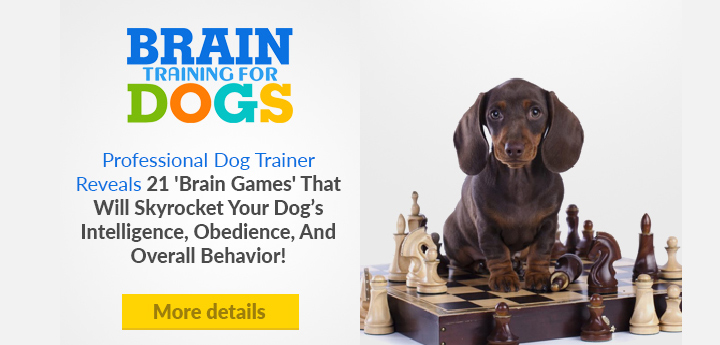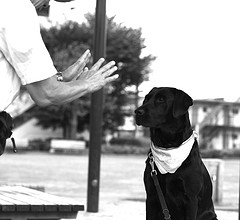Honestly, it’s easier said than done for many of us, but there really are some essential training tips every dog owner should know. If your dog isn’t willing to happily come when called, things can get pretty frustrating pretty fast. Having the communication skills to have your dog also sit, lie down, or stay when needed makes life even easier with your canine companion. The ability to direct your dog to leave something alone can downright save his life.
Know 5 Basic Dog Obedience Commands
- Come
- Sit
- Down (lie down)
- Stay
- Leave it (drop it)
Some folks say there are 5 basic commands, while others will add up to 10 to the mix . . . so what’s the actual number? As many as you can and your canine companion can master! The 5 basics we’ve listed here because they really are basics that make your life (and your dog’s life) a lot easier.
We also highly recommend using physical signals in conjunction with the simple words. For example, if you cross your arm over your chest ever time you’re teaching your dog to respond to the word “Come” then pretty soon all you need is your dog’s name (to get his attention) and the arm gesture to get him to come.
For sit and lie down we’ve had great luck with using our hands with your index finger pointing up accompanying the command “sit” and your index and next finger both pointing down accompanying the command “down.”
With a new dog, it really doesn’t matter where you actually begin, it’s all about just beginning! Practice regularly (daily or even twice a day) and try to never be in a hurry to move onto the next concept. Let your dog set the pace, even though that may only last a few minutes. If you’re working on “sit” just keep working on sit until Bart surprises you and sits upon command. If you push your dog longer than his attention span, and offer up every command you can think of at once you’ll frustrate the both of you.
Positive Reinforcements Outweigh Punishments
Your dog really does want to please you, but getting his attention and keeping it can be tricky, especially at first and particularly with a young pup. While training treats (something that small that isn’t going to pack the pounds on Bart as he’s learning what pleases you) are great, petting your dog and a happy voice go a long was as rewards, too.
Little bits of American cheese are a decent reward. A slice of a hot dog will liven up the interest of any dog that’s not paying attention. The size of your dog obviously plays an important role in determining what training tidbit will work best.
We like using training treats like Zuke’s Mini Naturals (they have a lot of different flavors and pouch sizes) or Little Jacs small dog training treats (perfect for small breeds).
Verbal praise has a range from overjoyed to a calm ‘good dog’ as Bart grows up and becomes more experienced. Don’t make the cheese or frankfurters redundant when practicing and as each word command is fully learned, slowly replace treats as rewards with a simple “yes!” or “good dog” or just a huge smile.
Always End Training on a Good Note
This is definitely a tactic every horse owner is aware of, but dog owners often forget. It’s important to leave your furry friend with a positive experience of your training sessions. If Bart managed to sit when you asked him to sit, even if it only lasted 2 seconds, tell him how great it was. Stress how pleased you are that he got it right. And end it there, on a positive note.
Pick Your Timing
Don’t begin a training session right away after dog has just eaten, he’ll be tired and those food rewards won’t be as tempting. Still, you can practice at any time during the course of the day, even if it is the 3 second “stay.” Your dog will appreciate the attention.
Sometimes a great opportunity for training comes just after a walk, provided it wasn’t a long-winded hike and you’re both too tired to engage in a training session.
Speak Clearly & Concisely!
When using the phrase training commands, remember that lesson. Your dog’s name gives you his attention; one word phrases tell him what to do. For example, “Bart, SIT.”
What you want to avoid is, “Bart, Sit. Sit. Sit. Bart, you’re not paying attention to me – I told you to Sit, now Sit, Bart. SIT, Bart!” This is what is called nagging, and your dog will completely tune you out.
Bart is not being disobedient or stubborn, he’s confused from your constant jabbering and it’s tough for him to hear and understand what he needs to hear and understand! It’s easy to get caught up, we’ve all been there.
Try to make sure you don’t sound like a drill sergeant. Instead, just smile, speak in a clear tone, and let Bart do the barking – not you!
Want more help?! Brain Training for Dogs is a great resource for eliminating any bad behaviors by tapping into your dog’s hidden intelligence. It’s great because it’s created by professional CPDT-KA certified dog trainer, Adrienne Farricelli, an advocate of gentle and force-free training techniques which rely on positive reinforcement instead of punishment.
Adrienne uses techniques that cause dogs to look forward to learning, and further strengthens the bond between dog and owner. There are 21 games to improve your dog’s intelligence (and behavior) along with easy to understand instructions for training obedience commands.







3 Comments
Hi,
Could you tell me if you have ever used the Tri-tronics classic 70 collar or even the Tri-tronics sport basic? I have heard people have wonderful outcome with this type of training but I am not sure it is the right way to train. Any advice would be welcomed as I am planning on getting yet another new addition to the family. I have has wonderful luck so far teaching the basic commands to my two cuties here.
Thanks,
Deb
D Verville – I have never used Tri-tonics collars. I’ll have to look them up and do some research.
These are really vital commands to teach your pet. They help you keep your dog in control while out and about, in social situations, and helps you check them out in case of ticks or illnesses. It’s just good pet parenting, and these specific commands are pretty easy to teach.